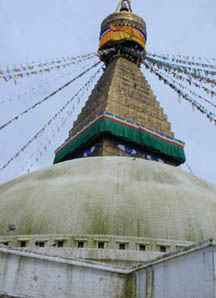 August 2004
August 2004
“Katmandu, I’ll soon be touching you and your strange bewildering time ……” Cat Steven’s song and books like James Hilton’s “Lost Horizon” I read many years ago always made me think of this city as a fascinating, mysterious place, gateway to the Himalayas and Tibet. We finally visited Katmandu for two weeks to see for ourselves. It wasn’t very mysterious but fascinating nevertheless, only in a way quite different from what we expected.
First of all, it was in the middle of the Monsoon season. It usually rained during the
night, sometimes during the day for a short period of time. So this wasn’t much of a problem for us except clouds covered the upper part of the mountains all the time and we did not see much
of the Himalayas. Only on the way home did we catch a glimpse of Mount Everest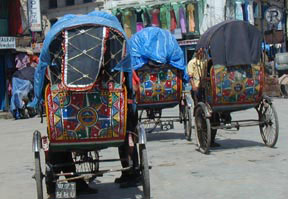 from the airplane. But we didn’t go there to see or even trek into the mountains. We wanted to experience the people and their culture which is so different from what we ever
encountered. Most streets are narrow and crooked, hardly wide enough to let two cars pass each other. There are no sidewalks. On both sides of the road there is a steady stream of pedestrians, school children in their
uniforms, women in colorful saris, men
from the airplane. But we didn’t go there to see or even trek into the mountains. We wanted to experience the people and their culture which is so different from what we ever
encountered. Most streets are narrow and crooked, hardly wide enough to let two cars pass each other. There are no sidewalks. On both sides of the road there is a steady stream of pedestrians, school children in their
uniforms, women in colorful saris, men 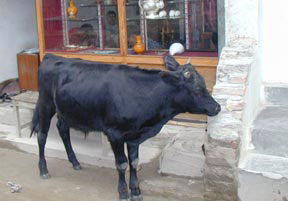 usually in ordinary clothes.
Brightly painted rickshaws are everywhere trying to get our attention. Occasionally a cow or two block the road, oblivious to their surroundings, searching for food or just resting in front of a store. Cars are honking
constantly while winding their way through the crowds. Small stores, sometimes not much more than holes in the wall, line the streets. Peddlers follow every tourist relentlessly trying to sell their wares. Young children
carrying their baby brother or sister on their backs are holding out their hands begging for money, sometimes asking us to buy them milk. Holy men in yellow robes, faces painted yellow, want to give us their blessings, a dab of
red and yellow paste on the forehead – for a fee. Carol gives one of them a handful of small coins. He looks at them and says “that’s only a small blessing”.
usually in ordinary clothes.
Brightly painted rickshaws are everywhere trying to get our attention. Occasionally a cow or two block the road, oblivious to their surroundings, searching for food or just resting in front of a store. Cars are honking
constantly while winding their way through the crowds. Small stores, sometimes not much more than holes in the wall, line the streets. Peddlers follow every tourist relentlessly trying to sell their wares. Young children
carrying their baby brother or sister on their backs are holding out their hands begging for money, sometimes asking us to buy them milk. Holy men in yellow robes, faces painted yellow, want to give us their blessings, a dab of
red and yellow paste on the forehead – for a fee. Carol gives one of them a handful of small coins. He looks at them and says “that’s only a small blessing”.
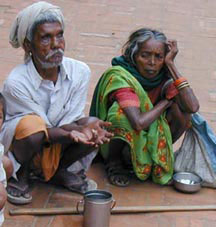 We are spending the first four days in Katmandu, mostly in the touristy, more picturesque Thamel area. There is no end to the many stores begging to be explored,
stores with Tibetan rugs, Thangka paintings with Buddha figures, the wheel of life or intricate mandalas, prayer wheels, brass water jugs decorated with peacock feathers and a set of eight small bowls for offerings to the gods.
Everything is so much more colorful here than in Thailand, temples are painted in bright red, blue, yellow or green colors. Even the small statues of Hindu gods in shrines that can be seen everywhere are covered with red and
yellow powder. People go past the shrines, apply powder and then put some back on their own foreheads for blessings and protection. Before leaving they ring one of the bells that can be found next to most shrines.
We are spending the first four days in Katmandu, mostly in the touristy, more picturesque Thamel area. There is no end to the many stores begging to be explored,
stores with Tibetan rugs, Thangka paintings with Buddha figures, the wheel of life or intricate mandalas, prayer wheels, brass water jugs decorated with peacock feathers and a set of eight small bowls for offerings to the gods.
Everything is so much more colorful here than in Thailand, temples are painted in bright red, blue, yellow or green colors. Even the small statues of Hindu gods in shrines that can be seen everywhere are covered with red and
yellow powder. People go past the shrines, apply powder and then put some back on their own foreheads for blessings and protection. Before leaving they ring one of the bells that can be found next to most shrines.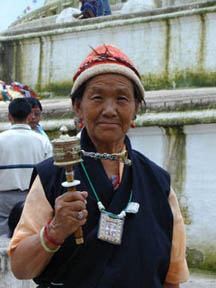
We discover the “Northfield Café” on the main road in Thamel, founded by a Northfield guy by the name of Michael years ago. It is mostly outdoors covered by a huge canopy as protection from the rain and sun. Next to a tall Buddha statue there is a raised section with a bar called “Jesse James Bar” with an American flag on the wall, a Route 66 sign and a Carleton College pennant. We are disappointed that a St. Olaf College pennant was missing. There are new owners now, a Thai and his Taiwanese-American wife. The “Northfield Café” becomes our favorite place to eat, the food is excellent, and every time the owner sees us he advises the waiter to give us a special discount because we are from Northfield.
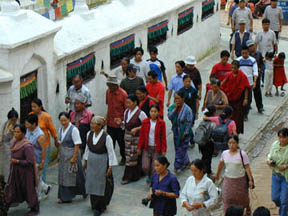 Four days are enough. It seems we can’t take in any more. We pack our suitcases and take a taxi to Bodhnath,
also called Boudha. Only about 5 km east of Katmandu it is like we are emerging into another world, a world we didn’t expect. The city itself is not much different from Katmandu but in
the center there is a multilevel tall Tibetan stupa with big Buddha eyes on all four sides looking down on us. On all sides hundreds of strings with prayer flags in many colors reach from the top all the way down to the
lower levels. There is a low wall at the bottom around the stupa with niches containing brass prayer wheels constantly kept moving by the many people walking clockwise around the stupa, 10 times, 20 times, 100 times. Some hold
prayer beads reciting their mantra “O mani padme hum”, others twirl handheld prayer wheels while walking. People look different here, not like Nepalese but Mongolian. This is the one place in Nepal with the most
Tibetans. Women don’t wear saris but traditional Tibetan outfits, monks wear darker robes than in Thailand. Ever
Four days are enough. It seems we can’t take in any more. We pack our suitcases and take a taxi to Bodhnath,
also called Boudha. Only about 5 km east of Katmandu it is like we are emerging into another world, a world we didn’t expect. The city itself is not much different from Katmandu but in
the center there is a multilevel tall Tibetan stupa with big Buddha eyes on all four sides looking down on us. On all sides hundreds of strings with prayer flags in many colors reach from the top all the way down to the
lower levels. There is a low wall at the bottom around the stupa with niches containing brass prayer wheels constantly kept moving by the many people walking clockwise around the stupa, 10 times, 20 times, 100 times. Some hold
prayer beads reciting their mantra “O mani padme hum”, others twirl handheld prayer wheels while walking. People look different here, not like Nepalese but Mongolian. This is the one place in Nepal with the most
Tibetans. Women don’t wear saris but traditional Tibetan outfits, monks wear darker robes than in Thailand. Ever  so often someone prostrates himself or herself on the ground again and again. The Boudha stupa is the tallest in
Nepal and considered a holy place. Buddhists come here as their pilgrimage. It has a diameter of 120 meters and the walk way around it is about 1/4 of a kilometer. Around the periphery there are hundreds of stores
with religious objects, paintings, Buddha statues, music stores, restaurants. As we walk around we hear the same music played all the time, the Tibetan
mantra “O mani padme hum”. We buy a CD and play it often here at home. It is difficult to get the music out of our minds. Last night I set up the laptop
upstairs in our bedroom and play the music. Carol falls asleep after only two minutes or so. Better than sleeping pills.
so often someone prostrates himself or herself on the ground again and again. The Boudha stupa is the tallest in
Nepal and considered a holy place. Buddhists come here as their pilgrimage. It has a diameter of 120 meters and the walk way around it is about 1/4 of a kilometer. Around the periphery there are hundreds of stores
with religious objects, paintings, Buddha statues, music stores, restaurants. As we walk around we hear the same music played all the time, the Tibetan
mantra “O mani padme hum”. We buy a CD and play it often here at home. It is difficult to get the music out of our minds. Last night I set up the laptop
upstairs in our bedroom and play the music. Carol falls asleep after only two minutes or so. Better than sleeping pills.
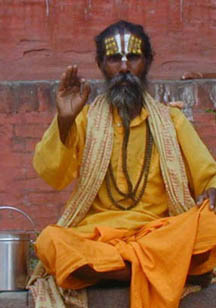 The area around the Boudha stupa is a busy place but somehow being there seems calm and relaxing. We feel
attracted to it and come back several times, but walk around the stupa usually only once or twice. There are simply too many stores to explore interrupting our walk. We buy a few
more CD’s, a Thangka painting with the Wheel of Life we want to hang up at our house back home, a handheld prayer wheel. We learn that our prayer wheel recites the mantra 10,000
times every time we turn it. We also discover its secret when the Tibetan sales woman opens it for us and shows us the rolled up scroll on which the mantra is written 10,000 times. In one
of the buildings next to a temple there is a huge prayer wheel, about 8 or 10 feet tall with a brass handle around it. People keep turning it constantly. It has one millions mantras written
on the scroll inside. Every time it completes a turn a bell rings allowing people to count how many million
The area around the Boudha stupa is a busy place but somehow being there seems calm and relaxing. We feel
attracted to it and come back several times, but walk around the stupa usually only once or twice. There are simply too many stores to explore interrupting our walk. We buy a few
more CD’s, a Thangka painting with the Wheel of Life we want to hang up at our house back home, a handheld prayer wheel. We learn that our prayer wheel recites the mantra 10,000
times every time we turn it. We also discover its secret when the Tibetan sales woman opens it for us and shows us the rolled up scroll on which the mantra is written 10,000 times. In one
of the buildings next to a temple there is a huge prayer wheel, about 8 or 10 feet tall with a brass handle around it. People keep turning it constantly. It has one millions mantras written
on the scroll inside. Every time it completes a turn a bell rings allowing people to count how many million 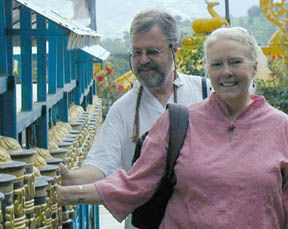 times their mantra has been sent.
times their mantra has been sent.
At the hotel we wake up at about 5 a.m. every morning. From the Tibetan temple right next to our room we hear the loud, very deep sound of gongs, followed by horns and the morning prayers of 12 monks. Then the gongs and the horns start up again followed by more prayers in a monotonous language we don’t understand. What a wonderful way to wake up. One afternoon we actually go inside the temple for the afternoon prayers to watch and listen. We sit on pillows to the side against the wall. After a while the monks are taking a break to drink a cup of Tibetan butter tea. One of them brings us two cups and fills it with tea. It tastes wonderful. We have to learn how to make it ourselves. We stay for maybe 45 minutes.
After three days we return to Katmandu, make a few trips to nearby places and then take the three hour flight on the Royal Nepal Airline back to Bangkok. This time we actually catch a glimpse of Mount Everest, hardly visible above the dense cloud cover.
What an adventure this was. We took almost 1000 pictures with our digital camera. To bad we can’t print them all. This week we heard on the BBC news that the TAOIST rebels set up a blockade around Katmandu trying to strangle the city demanding release of prisoners. It seems we just left in time.
This will be our last report from Asia. In less than three weeks we will be on our way back to the States after three years here, three years we will never forget.
P.S. Jan 15, 2005
The NGO directors wanted us to come back to teach for a couple of months spring 2005. But we wanted to visit our children, stay with Carol’s mom for a while in Oklahoma, and then move back into our house in Ft. Collins in June. Maybe we can manage in 2006. By now, this year’s AEIOU program has already started. There are about ten new and five returning students, we are told. Norbert is still the registrar for the school keeping in touch via e-mail.
We miss Thailand, we miss our students.